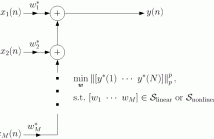- Multi-channel Signal Processing
- Sensor and Relay Networks
- Multi-antenna and Multi-channel Signal Processing for Communications
- Applications of Sensor Array and Multi-channel Signal Processing
- Adaptive Array Signal Processing
- Sensor Array Processing
Radar waveforms often need to be optimized to achieve minimal sidelobes in the ambiguity function. In this paper, it is shown that sampling rate can affect the optimality of the sidelobe level, so the sampling rate should be considered already at the optimization phase. A theorem for the cross-ambiguity function peak values of the oversampled waveforms is developed.
- Categories:
 9 Views
9 Views- Read more about COMPRESSIVE PULSE-DOPPLER RADAR SENSING VIA ONE-BIT SAMPLING WITH TIME-VARYING THRESHOLD
- Log in to post comments
- Categories:
 24 Views
24 Views- Read more about BAYESIAN RECONSTRUCTION OF HYPERSPECTRAL IMAGES BY USING COMPRESSED SENSING MEASUREMENTS AND A LOCAL STRUCTURED PRIOR
- Log in to post comments
This paper introduces a hierarchical Bayesian model for the reconstruction of hyperspectral images using compressed sensing measurements. This model exploits known properties of natural images, promoting the recovered image to be sparse on a selected basis and smooth in the image domain. The posterior distribution of this model is too complex to derive closed form expressions for the estimators of its parameters. Therefore, an MCMC method is investigated to sample this posterior distribution.
- Categories:
 16 Views
16 Views
- Read more about COHERENCE FUNCTION ESTIMATION WITH A DERIVATIVE CONSTRAINT FOR POWER GRID OSCILLATION DETECTION
- Log in to post comments
- Categories:
 Views
Views
- Read more about COHERENCE FUNCTION ESTIMATION WITH A DERIVATIVE CONSTRAINT FOR POWER GRID OSCILLATION DETECTION
- Log in to post comments
- Categories:
 2 Views
2 Views
In this presentation, the topic of robust beamforming is studied. We devise the minimum dispersion criterion which extends the minimum variance criterion from l2‐norm to lp‐norm. Formulations with different linear and nonlinear constraints are examined. The proposed framework generalizes existing approaches including the Capon and linearly constrained minimum variance beamformers as well as the method based on worst-case performance optimization. Computationally attractive algorithm realizations are also developed.
- Categories:
 364 Views
364 Views
- Read more about Discriminant Correlation Analysis for Feature Level Fusion with Application to Multimodal Biometrics
- Log in to post comments
In this paper, we present Discriminant Correlation Analysis (DCA), a feature level fusion technique that incorporates the class associations in correlation analysis of the feature sets. DCA performs an effective feature fusion by maximizing the pair-wise correlations across the two feature sets, and at the same time, eliminating the between-class correlations and restricting the correlations to be within classes.
- Categories:
 119 Views
119 Views- Read more about Target detection for depth imaging using sparse single-photon data
- Log in to post comments
This paper presents a new Bayesian model and associated algorithm
for depth and intensity profiling using full waveforms from timecorrelated
single-photon counting (TCSPC) measurements when the
photon count in very low. The model represents each Lidar waveform
as an unknown constant background level, which is combined
in the presence of a target, to a known impulse response weighted
by the target intensity and finally corrupted by Poisson noise. The
joint target detection and depth imaging problem is expressed as a
- Categories:
 13 Views
13 Views- Read more about Super-Resolution DoA Estimation via Continuous Group Sparsity in The Covariance Domain
- Log in to post comments
- Categories:
 5 Views
5 Views- Read more about Time Delay Estimation: Applications and Algorithms
- Log in to post comments
Time delay estimation refers to finding the time-differences-of-arrival between signals received at an array of sensors. In this presentation, representative applications of time delay estimation are first described. Algorithms for accurately estimating the time difference between two sensor outputs using random and deterministic signals are then presented and analyzed.
- Categories:
 847 Views
847 Views